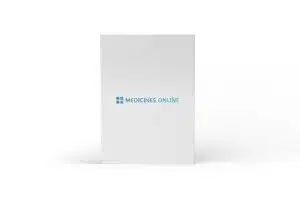What is the Shipping & Return Policy
We have a 14-day return policy, which means you have 14 days after receiving your item to request a return.
To Qualify for any return, the product must be in the same condition as when you received it. It is not used, not opened, unworn, and in its original packaging. You will also need to send it to us with the receipt or proof of purchase.
Please return to Medicines Online, 89 Falcon Rd, London. SW11 2PF
You can read our return policy here:
https://medicinesonline.org.uk/return-policy/
We offer next-day delivery. However, courier delivery times are out of our control. We are unable to provide refunds for any late deliveries. But you will receive courier tracking information once your order has been dispatched. Orders placed by 1 pm are posted on the same day.
Polysistic ovary syndrome Shared Stories and Cases
- Living With PCOS: Real Stories From Those Who Found Support After Diagnosis
Polycystic Ovary Syndrome comes with a laundry list of challenging symptoms—from acne to hair loss, weight gain to sometimes infertility. But it’s so much more than that—for many, like this writer, it represents a part of their life that will always be a mystery.
When I was first diagnosed with polycystic ovary syndrome (PCOS) I was 17, and riddled with all the insecurities that came with the age. I showed up at my dermatologist appointment hoping to find a quick-fix to my cystic acne so I could be on my way to college looking like a Noxzema commercial. But instead of some topical cream and a “good luck”, the doctor paused, scanned my body and face, and diagnosed me with PCOS—also known as polycystic ovarian syndrome—on the spot…and then sent me on my way. But before she did, she referred me to an endocrinologist at NYU who happened to be doing research on the condition—which I would discover was still very much a subject of ongoing investigation in the medical field.
The new doc measured my glucose levels and scanned my abdomen with an ultrasound wand and the accompanying goo to explore my ovaries. Sure enough, she said they were peppered with the telltale sign of the condition—small fluid cysts known as follicle cysts that looked like a string of pearls. And my glucose levels were elevated because those cysts had a knock-on effect that threw my hormone levels out of whack and caused my body to be resistant to insulin. She told me to “try to eat less pizza” in college, mentioned breezily that it could impact my ability to have kids, and then she, too, sent me on my way, this time with a prescription for the birth control pill plus a medication to induce my pretty irregular period. (Luckily I would go on to have much better doctor-patient experiences than this.)
That was basically the end of it, minus an oppressive feeling that something was wrong with me, until—fast-forward 15 years—I was ready to try for that baby. When it took me more than a minute to get pregnant, all the feelings and thoughts from being a teen in those doctors’ offices flooded back to me. The feelings had been there all along, just in hibernation since so much of PCOS feels attached to fertility. For me, when I wasn’t thinking about fertility, I wasn’t thinking about my PCOS. I brought it up with my OBGYN and once again, he reached for that ultrasound wand (this time it was transvaginal instead of abdominal) and on searching, he found no evidence of PCOS—just one small cyst on my ovary that he didn’t seem to be too worried about. So what? Was that the end? And while I was lucky enough to get pregnant with my now-6-year-old daughter as I write this, days after my 40th birthday, a cystic zit on my cheek stands as a reminder that I don’t feel totally out of the woods. I still feel like I may, or may not, have PCOS.
PCOS is still underfunded, under research, and ignored. We need much greater awareness and support from the medical and scientific community, and unfortunately to date, the burden has been on PCOS patients to fight for this recognition.
- More than just physical symptoms
I’m not the only one on a PCOS roller coaster ride. Anyone who has been diagnosed with the condition knows the lengthy list of symptoms that can feel totally unrelated other than they can really suck sometimes (see above) but yet they can somehow be traced back to the hormonal imbalances caused by those cysts. If you’ve suffered from PCOS, you also know the condition is so much more than just those symptoms—it also comes with a swath of emotions and unknowns. “Among a long list of contributors, the chronic inflammation, imbalanced hormones, and stress of getting diagnosed with and treating the condition all play significant roles in decreased mental health,” says Felice Ramallo, MSCN, RDN, LD/CDN, the lead dietician at Allara, a telehealth company dedicated to supporting people with the condition.
For many like me, the biggest unknown is whether or not you actually have the condition. As many as 68% of women with PCOS go undiagnosed. And that doesn’t account for people like me whose diagnosis toggles off and on with the wind, depending on the doctor. “That’s in large part because PCOS is still underfunded, under research, and ignored,” says Rachel Blank, founder and CEO of Allara. “Even though PCOS is the most common endocrine disorder in women, and one of the leading causes of infertility, less than 0.1% of NIH research funding goes towards PCOS research. We actually don’t have a single FDA approved medication for the treatment of PCOS, even though it’s been a known condition for over 100 years. We need much greater awareness and support from the medical and scientific community, and unfortunately to date, the burden has been on PCOS patients to fight for this recognition.”
Part of the problem is it’s a syndrome, which means science doesn’t know the exact cause of PCOS, and sees it more as a group of symptoms—though all signs point to those ovarian cysts. (If you’re thinking “what about PCOD—polycystic ovary disease?” It is a thing, but it’s milder and rarely causes problems with fertility.) So while there needs to be more awareness on the condition, supporting each other is key. “Managing PCOS, like many forms of infertility, can be a very isolating experience,” says Lauren Berson, founder and CEO of Conceive. “Not nearly enough people talk about it publicly due to the continued shame and stigma associated with infertility and the challenging symptoms of PCOS, so we are forced to form underground communities of women who are suffering in silence—and yet, are just looking for support. What’s more, there’s a lot of misinformation out there about whether you can conceive with PCOS—and a lack of good care unless you are trying to conceive. We almost don’t care whether you have this until you’re trying to get pregnant. It’s wild!” It’s with this in mind that Berson created Conceive, to create a safe space for people with fertility conditions like PCOS.
- Glee star Lea Michele turned to singing as solace
Lea Michele, 36, she spoke candidly about her PCOS. And it sounded remarkably like my story. “I started taking birth control when I was 14 because of my skin but no one was considering polycystic ovary syndrome,” she said. “Everyone was saying, oh, you just genetically have bad skin, you must have a higher level of testosterone.” So she stayed on birth control until she was 30 years old and it did help her skin, “which was great, because I’ve been working professionally since I was very young and having skin issues was very traumatizing for me, not only just being a high school student, but then also having to perform on stage or on camera,” she added.
But then, like me, when she turned 30, she decided to come off birth control to get pregnant—but she didn’t get her period for a whole year. “I’m pretty in tune with my body and I figured something must be wrong. And after going to multiple doctors, I finally found a wonderful doctor in Los Angeles. She looked at me and she just said, you have PCOS. And I was like, what is that? And she explained what it was.”
The star of Broadway’s Funny Girl was able to manage it for a while, but this changed when she was trying to conceive. “I remember when my husband and I were first starting to try, the worst thing you can ever do is Google,” she explained. “[If you Google] issues of conceiving with PCOS, it’ll say you have a higher risk of having miscarriages or you have a higher risk of not conceiving and it’s terrifying. It’s truly terrifying. So I’m very lucky that I was able to find, after a challenging search, some great doctors who were able to help me manage the PCOS, care for the damage that it had done on my body to then prepare for me to get pregnant. And we’re very fortunate that it was successful.” But of course, it wasn’t so simple, and with the struggles to get pregnant came the anxiety that sets in when you’re actually pregnant. And for that, Michele turned to what she loves to do best best. For her, it’s singing: “I used it to truly heal and to help bring me strength in a way that I never had before.” But for anyone else struggling, it could be anything else that makes you happy.
 Easy to use finger-prick Sample
Easy to use finger-prick Sample Includes return postage
Includes return postage Sample Kit delivered to your home
Sample Kit delivered to your home Result emailed within 1-3 days
Result emailed within 1-3 days Luteinising Hormone
Luteinising Hormone Testosterone
Testosterone FSH
FSH Free androgen index:
Free androgen index: Sex Hormone Binding Globulin
Sex Hormone Binding Globulin





